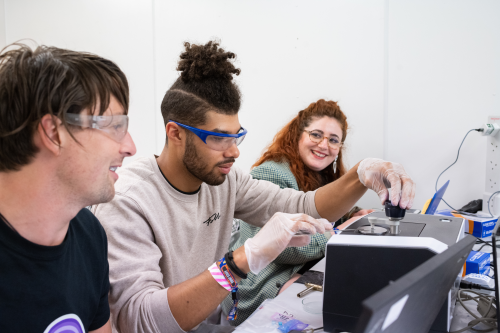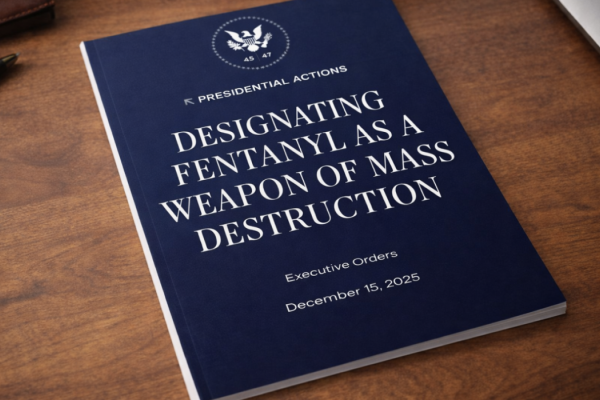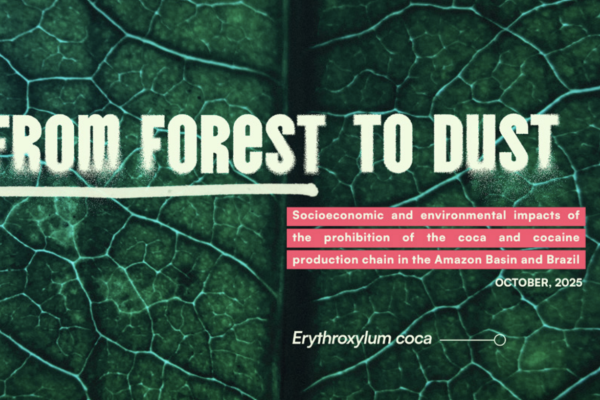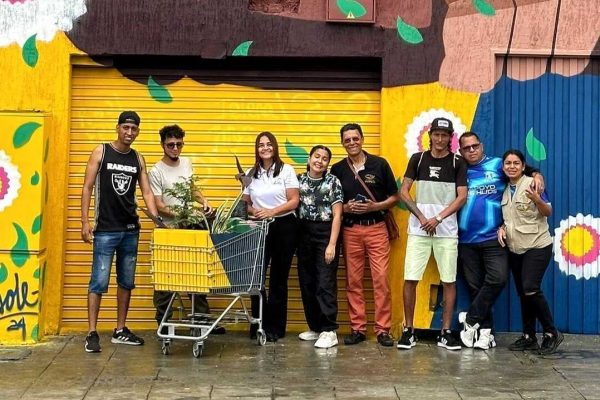26th January 2024
Image credit: The Loop
This blog is written by Professor Fiona Measham (Chair in Criminology, University of Liverpool, Drug Science member & founder and Chair of The Loop).
Saturday 27th January 2024 is a red letter day for drug checking and for harm reduction more generally in the UK. After 12 years of preparations, evaluations and negotiations, The Loop starts the UK’s first regular drug checking service (DCS)[1]. With more cities due to follow soon, this launch represents the start of a new era for drug checking and it could not come at a more important time. Drug-related deaths have increased year on year to nearly 5,000 in 2022 [2]. The National Crime Agency estimates that two people are dying every week from synthetic opioids, with this figure expected to rise [3]. The risks from adulteration of the illegal drug market have never been greater and the need to know what is in circulation has never been stronger.
The good news is that a Home Office-licensed, local government-commissioned, fully funded, regular DCS starts in Bristol city centre tomorrow. There is much to rejoice about in this milestone but it has been neither plain sailing getting to this point, nor unconditional now it is here. As ever in the drugs field, it has been a long and winding road with unexpected twists, turns and cul-de-sacs, rather than linear progress, however tempting it might be to impose that narrative.
Turn back the clock 12 years and drug treatment conversations were focused on abstinence, 12-step programmes and getting service users out of treatment and into recovery who were ‘parked’ on methadone. Harm reduction was pretty much banished from local funding agendas and central policy making. Purity was at an all time low in street drug markets and the new kids on the block were the ‘legal highs’ – especially synthetic cathinones like mephedrone [4] and synthetic cannabinoids like ‘spice’. Policy debates were focused on how to control these New Psychoactive Substances – through generic controls, temporary control drug orders, tiered regulatory frameworks and eventually blanket bans – and policy questions focused on how to keep up with the rate and scale of innovation, manufacturing, marketing and trafficking, both across continents and online.
Drug checking was something which happened in other countries, most notably the Netherlands, and the general consensus was that it was impossible to introduce drug checking in the UK without legislation, there was no political interest in doing so, and there was not considered to be a robust enough international evidence base to win over significant support in the country, inside or outside Parliament. Added to this was the view that there wouldn’t be much uptake from people who use drugs anyway. Why would anyone give away their drugs for free?
Getting drug checking across the line has been a different process in different political contexts in different countries and regions. In the UK the characteristics have included pilots, evaluations, publications and in particular, negotiations with national and local stakeholders for over a decade.
Stepping stones
The path from non public to public testing in the UK can be characterised as a stepping stone approach. The Loop initially starting with ‘back of house’ non public testing of substances of concern from medics, welfare and police in nightclubs [5] from 2013 and in festivals from 2014, with the first event-based testing service primarily for harm reduction purposes. The inspiration for this came from TICTAC which was the first city testing service based in a fixed site London hospital lab. Established in 1999, TICTAC has been testing substances of concern from health services, police and nightclub amnesty bins for over 25 years, and from festivals since 2007. Hearing TICTAC presentations to the Advisory Council on the Misuse of Drugs (where I served from 2008-18) and shadowing TICTAC and Home Office chemists onsite at Creamfields and Glastonbury from 2010, I saw their use of Fourier-transform infrared spectroscopy (FTIR) in operation.
FTIR was paired with a regularly updated TICTAC reference library to match and identify unknown substances from seizures, confiscations and ground finds within minutes. The Loop switched the focus of FTIR onsite testing from police intelligence to harm reduction. The first back of house testing event by The Loop in 2013 was supported onsite by the loan of a Home Office FTIR and guidance on its use from Home Office chemists. Less supportive were some academic chemists and medics who were publicly critical of the suitability of utilising FTIR for drug checking.
The value of this stepping stone approach lay in building partnerships and jointly developing multi agency working practises onsite at events for three years, delivering prompt test results from professional chemists, contextualised by criminologists in local, national and international drug market trends. Stakeholders could see the added value of onsite testing for harm reduction purposes for themselves, witnessed directly for the first time, through ‘meet and greet’ lab tours open to all, and visited by scores of police, public health, press and other dignitaries. This demystified the process of forensic analysis and showed at first hand some of the extraordinary substances circulating in local drug markets, which were highlighted for their increased risk, disturbing effects, or sometimes just the audacity of suppliers.
Pilots
Showing the value to receiving prompt and accurate information about what is in circulation was invaluable to building stakeholder relations. The missing link in this dissemination of test results became starkly evident, however. People who are taking or considering taking these substances also need the opportunity to access testing services to obtain this information and the expertise to guide them through the relative risks incurred. It was a logical, reasonable next step to push to pilot publicly accessible DCSs. Attending European conferences and hearing presentations from drug checking services like DIMS and Energy Control showed that publicly funded drug checking, free at point of care, was possible, and those examples were shared with UK stakeholders.
The pilot years of 2016-18 were possible only because of three sets of extraordinary people. The first is the chorus of talented, committed, professional chemists, health professionals and others who gave their time freely to staff The Loop service and were united in developing and delivering a vision of doing things differently. The second is the group of innovators from across the different stakeholder groups – most notably senior figures in the police, events industry, press, and local and central government – who took a degree of professional risk in supporting The Loop to take those next steps. The last group, and by no means least, is service users themselves, who trusted the process, queued, surrendered their drugs for testing and destruction, and enthusiastically embraced the concept.
Evaluations
Would it work? Would it increase drug use rather than decrease harm? Would anyone give away their drugs for testing?
Three years’ evaluations of festival [6] and city centre pilots [7] were published at a time when it would be fair to say that the evidence base for DCSs was ‘emergent’. Since then, evaluations have been published, outcome measures developed, and the evidence base blossomed across Europe, North America and Australasia. The evidence is coalescing that (unsurprisingly) the majority of service users throw away substances which they don’t want and a significant minority take smaller amounts when informed of high strength substances alongside individually calibrated dosage advice. Reduced consumption of adulterants reduces the risk of poisoning and reduced dosage reduces the risk of overdose. Whilst the hook to bring hidden populations into a DCS is clearly the test result, it is increasingly evident that the added value of drug checking is in the dialogue with health professionals and communication of relative risk.
In the UK there is also growing confusion and some evidence of definition creep around what exactly drug checking is or isn’t, however, and whether health consultations are even an essential part of the service. Whilst it can be seen as a positive sign of just how much drug checking has moved from the margins to the mainstream in this wider embrace, the challenge, as we saw last summer, occurs when commentators, journalists or even Parliamentary committees [8] make recommendations regarding drug checking based on varying definitions and it is unclear what it is that they are advocating for.
A number of other services across the UK have been awaiting The Loop receiving this ‘test case’ licence and are now submitting theirs. We hope and anticipate that there will be a network of multiple DCS providers by the end of 2024. These provide an opportunity to monitor drug trends; support and signpost people to drug treatment and other local services; reduce drug-related harm and the associated burden on the NHS; and most importantly centre people who use drugs at the heart of the decision-making processes around drug use. With amongst the highest drug-related death rates on record and in Europe, tomorrow cannot come soon enough.
References
- The Loop utilises this definition of drug checking: “Drug checking combines chemical analysis with health consultations, with the primary aim of reducing harmful drug use and primary characteristic of direct engagement with people who use drugs.” (Measham, F. & Turnbull, G., [2021], Intentions, Actions and Outcomes: A follow up survey on harm reduction practices after using an English festival drug checking service, International Journal of Drug Policy, 95: 1-10. 103270. https://doi.org/10.1016/j.drugpo.2021.103270. See also: Barratt, M. and Measham, F. [2022], What is drug checking, anyway? Drugs, Habits and Social Policy, 23 (3), 176-187. https://doi.org/10.1108/dhs-01-2022-0007.
- Office for National Statistics (ONS), released 19 December 2023, ONS website, statistical bulletin, Deaths related to drug poisoning in England and Wales: 2022 registrations. https://www.ons.gov.uk/peoplepopulationandcommunity/birthsdeathsandmarriages/deaths/bulletins/deathsrelatedtodrugpoisoninginenglandandwales/2022registrations
- Holland, A., Copeland, C., Shorter, G., Connolly, D., Wiseman, A., Mooney, J., Fenton, K. and Harris, M. (2024), Nitazenes—heralding a second wave for the UK drug-related death crisis? Lancet Public Health, 12th January. https://doi.org/10.1016/S2468-2667(24)00001-X . See also: Booth, R., (2024), People buying opioids and sedatives online face deadly fakes, expert warns, The Guardian, 17th January, https://www.theguardian.com/society/2024/jan/17/opioids-sedatives-online-deadly-fakes-nitazenes
- Measham, F., Moore, K., Newcombe, R. and Welch, Z. (2010), Tweaking, Bombing, Dabbing and Stockpiling: The emergence of mephedrone and the perversity of prohibition, Drugs and Alcohol Today, 10 (1): 14-21.
- https://www.theguardian.com/society/2013/dec/01/drug-testing-warehouse-project-nightclub
- Measham, F. and Simmons, H. (2022), Who uses drug checking services? Assessing uptake and outcomes at English festivals in 2018, Drugs, Habits and Social Policy, special issue on drug checking, 23 (3), 188-199. https://doi.org/10.1108/DHS-02-2022-0008.
- Measham, F. (2020), City Checking: Piloting the UK’s first community-based drug safety testing (‘drug checking’) service in 2 city centres, British Journal of Clinical Pharmacology, Special Issue: New Psychoactive Substances, 86 (3): 420-428. https://doi.org/10.1111/bcp.14231. See also: www.wearetheloop.org/publications
- Home Affairs Committee (2023), Home Affairs Committee Third Report of the 2022-23 Session on Drugs, https://publications.parliament.uk/pa/cm5803/cmselect/cmhaff/198/summary.html.
Image credit: The Loop




